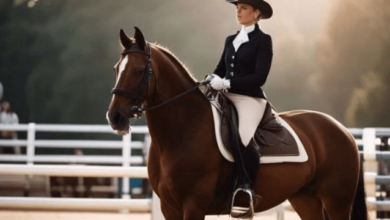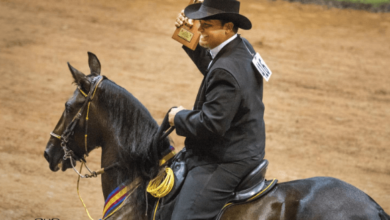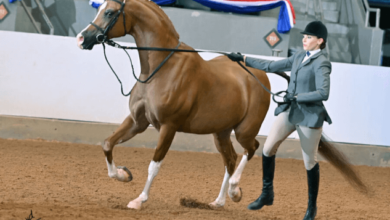How can I train my horse for western pleasure?

Western pleasure is a popular and rewarding equestrian discipline, known for its grace, control, and elegance. Riders in Western pleasure showcase their horses’ ability to move with a relaxed, free-flowing gait while maintaining smooth transitions between gaits. Training a horse for Western pleasure is an art that requires time, patience, and a clear understanding of what judges are looking for in the show ring. Whether you’re new to the sport or an experienced rider aiming to refine your horse’s performance, this guide will walk you through the essential steps to train your horse for Western pleasure successfully.
Understanding the Basics of Western Pleasure
Before diving into training techniques, it’s crucial to understand what Western pleasure entails. In a Western pleasure class, horses are judged on their ability to exhibit smooth and steady movement at the walk, jog, and lope. Judges focus on the horse’s manners, attitude, responsiveness to the rider, and overall movement. The goal is to present a horse that is a pleasure to ride—calm, well-mannered, and collected.
The three primary gaits you’ll focus on are:
- Walk – A slow, natural, and flat-footed gait.
- Jog – A slow trot that is two-beat, smooth, and easy to sit.
- Lope – A relaxed, controlled three-beat canter.
These gaits must be executed with a relaxed head carriage, minimal rein pressure, and a visible sense of harmony between the horse and rider.
Building a Strong Foundation
Every successful Western pleasure horse starts with a solid foundation of basic training. Before you attempt to teach specialized Western pleasure techniques, ensure that your horse is confident and comfortable with the fundamentals of riding. This includes groundwork, softening to the bit, bending, flexing, and responding to your cues with precision.
- Groundwork First
Groundwork is essential for teaching your horse respect, responsiveness, and obedience. Begin with lunging, desensitizing exercises, and teaching your horse to move away from pressure. These exercises build trust and establish you as the leader, which is crucial when you move on to more advanced riding techniques. - Saddle Training
Before you start training for Western pleasure, your horse should be well-acquainted with basic saddle work. Ensure your horse knows how to walk, trot, and canter with a rider on its back. Work on stopping, backing up, and maintaining steady gaits. Focus on maintaining softness in your horse’s mouth by using light rein pressure and rewarding any signs of relaxation and compliance.
Refining Gaits for Western Pleasure
In Western pleasure, your horse’s gaits need to be slow, controlled, and comfortable to sit. However, the challenge lies in keeping these movements natural and not mechanical. Here’s how you can refine each gait for optimal performance:
- The Western Pleasure Walk
The walk is the most natural gait, but it still requires finesse. Start by encouraging your horse to maintain a steady, four-beat rhythm. Your horse should walk forward with purpose, but not rush. Use your legs and seat to maintain forward momentum, while using soft reins to keep the head level and the neck relaxed. Practice walking in large circles and straight lines to ensure your horse can move evenly and steadily in different patterns. - Training the Jog
The jog is one of the most recognizable gaits in Western pleasure, known for its slow and smooth rhythm. To develop a good jog, start by working your horse at a regular trot and gradually slow it down. Use your seat to control the pace—sit deep and relax, signaling your horse to shorten its stride without losing rhythm. Practice jogging on a loose rein, as a light contact is preferred in Western pleasure. If your horse tends to rush or become tense, practice half-halts to remind it to slow down and stay balanced. - Perfecting the Lope
The lope in Western pleasure is a controlled, three-beat gait that exudes calmness and flow. Many horses naturally want to rush the lope, so you’ll need to teach your horse to move slowly and with control. Start by working on transitions between the walk and lope. Practice pushing your horse into a lope from a standstill, ensuring that the transition is smooth and relaxed. Once in the lope, use your seat and voice to encourage your horse to maintain a slow, collected pace. Avoid pulling on the reins, as this can disrupt the natural flow. Instead, use your body and legs to regulate speed and balance.
Collection and Frame
An important aspect of Western pleasure is teaching your horse to move in a collected frame. Collection refers to the horse carrying itself in a balanced manner, with its hindquarters engaged, back lifted, and head in a relaxed position. A horse that is collected moves with power and grace, making it a pleasure to watch and ride.
- Teaching Collection
Start by encouraging your horse to soften to the bit. Use gentle pressure on the reins to ask your horse to lower its head while maintaining forward movement. At the same time, drive with your legs to keep your horse’s hindquarters engaged. When your horse responds by rounding its back and softening its head, release the pressure as a reward. - Working on Circles
Circles are excellent for improving collection and balance. Ride your horse in large, even circles, gradually making them smaller as your horse becomes more comfortable. Keep your horse between your legs and hands, guiding it with soft rein pressure and leg cues. As your horse gets better at maintaining balance, you’ll notice its frame improving naturally.
Improving Transitions
Smooth, seamless transitions are a key part of a winning Western pleasure routine. Judges will expect your horse to move effortlessly from one gait to another without resistance or disruption in rhythm. Work on transitions between the walk, jog, and lope, focusing on maintaining your horse’s balance and composure throughout.
- Walk-to-Jog Transitions
Practice moving from a walk to a jog by using subtle leg pressure and your seat. The transition should be smooth and relaxed, with minimal rein contact. If your horse tries to rush the jog, use half-halts to slow down the pace. - Jog-to-Lope Transitions
When transitioning from a jog to a lope, ensure your horse is collected and balanced. Use your seat to push your horse into the lope, avoiding the temptation to kick or pull on the reins. Practice transitioning in both directions to build strength and coordination. - Lope-to-Jog Transitions
To bring your horse back to a jog from a lope, sit deep and use gentle rein pressure to slow down. The transition should be smooth, without your horse rushing or becoming unbalanced.
Mastering Showmanship and Presentation
Training your horse for Western pleasure isn’t just about the technical aspects of the gaits. You’ll also need to focus on showmanship and presentation, as these play a crucial role in the judging process. Here’s what to keep in mind:
- Appearance
Judges will be looking for a horse that is well-groomed and neatly presented. Make sure your horse is clean, with a shiny coat, trimmed mane, and polished hooves. The tack should also be clean, fitting well, and appropriate for Western pleasure. - Rider Position
Your position as a rider is just as important as your horse’s performance. Maintain a straight posture with your shoulders back and relaxed. Keep your legs still, and use subtle cues to communicate with your horse. Your hands should remain low, with light contact on the reins. Remember, less is more in Western pleasure—your goal is to look like you’re riding with minimal effort. - Attitude and Confidence
Western pleasure horses are expected to perform with a calm and willing attitude. Make sure your horse is well-mannered and responds promptly to your cues. Confidence in both the rider and horse will go a long way in impressing the judges.
Frequently Asked Questions (FAQs)
- How long does it take to train a horse for Western pleasure?
Training a horse for Western pleasure can take anywhere from several months to a few years, depending on the horse’s temperament, experience, and how frequently you train. Consistent, patient training is key. - Can any horse be trained for Western pleasure?
While some horses may naturally excel at Western pleasure due to their movement and temperament, most horses can be trained for the discipline with the right techniques and patience. However, horses with calm, steady gaits and a willingness to please are usually more suited for Western pleasure. - What equipment is needed for Western pleasure training?
Basic equipment includes a Western saddle, a snaffle bit or curb bit (depending on the horse’s training level), and reins. You may also use leg wraps or boots to protect your horse during training sessions. - How often should I train my horse for Western pleasure?
Aim to train your horse 4-6 days a week, with sessions lasting between 30 minutes to an hour. Consistency is key, but be mindful not to overwork your horse. Allow time for rest and recovery. - How do I know if my horse is ready for a Western pleasure competition?
Your horse is ready for competition when it can consistently perform all three gaits—walk, jog, and lope—smoothly and in a collected frame. Additionally, your horse should be calm, responsive, and capable of maintaining its focus in a busy show environment. - What should I do if my horse gets frustrated during training?
If your horse shows signs of frustration, take a break and assess the situation. Sometimes, frustration can be a result of overtraining or confusion. Go back to basics and reward your horse for small achievements to rebuild its confidence.
Conclusion
Training your horse for Western pleasure takes time, patience, and a keen understanding of the discipline’s requirements. By focusing on building a solid foundation, refining gaits, improving transitions, and perfecting showmanship, you can prepare your horse for success in the Western pleasure show ring. Remember, the key to Western pleasure is presenting a horse that moves smoothly, confidently, and willingly—a true pleasure to ride.



